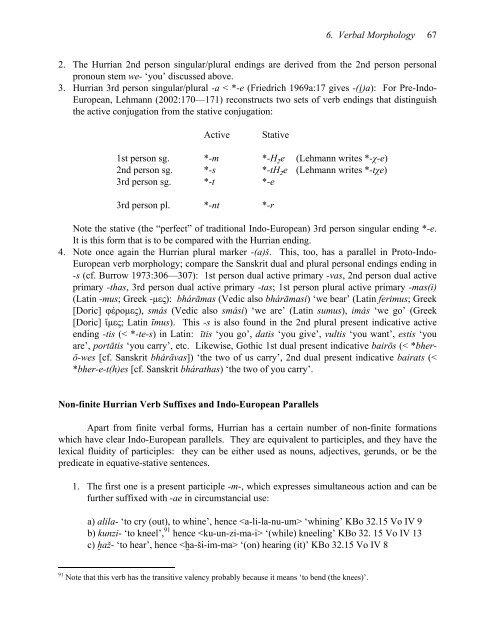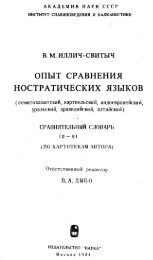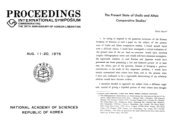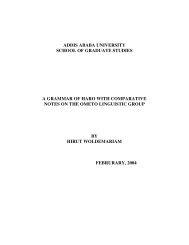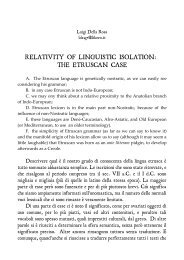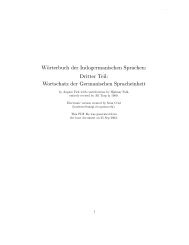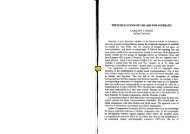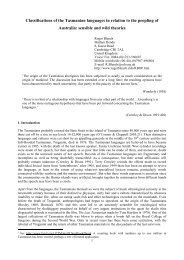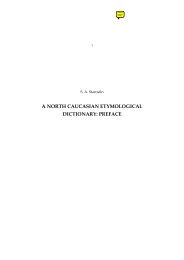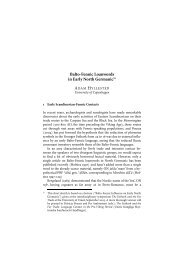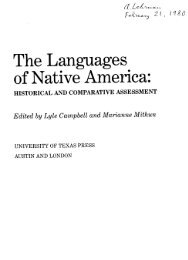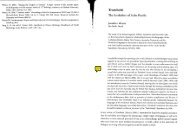The Indo-European Elements in Hurrian
The Indo-European Elements in Hurrian
The Indo-European Elements in Hurrian
Create successful ePaper yourself
Turn your PDF publications into a flip-book with our unique Google optimized e-Paper software.
6. Verbal Morphology 67<br />
2. <strong>The</strong> <strong>Hurrian</strong> 2nd person s<strong>in</strong>gular/plural end<strong>in</strong>gs are derived from the 2nd person personal<br />
pronoun stem we- ‘you’ discussed above.<br />
3. <strong>Hurrian</strong> 3rd person s<strong>in</strong>gular/plural -a < *-e (Friedrich 1969a:17 gives -(Ô)a): For Pre-<strong>Indo</strong>-<br />
<strong>European</strong>, Lehmann (2002:170—171) reconstructs two sets of verb end<strong>in</strong>gs that dist<strong>in</strong>guish<br />
the active conjugation from the stative conjugation:<br />
Active Stative<br />
1st person sg. *-m *-Høe (Lehmann writes *-χ-e)<br />
2nd person sg. *-s *-tHøe (Lehmann writes *-tχe)<br />
3rd person sg. *-t *-e<br />
3rd person pl. *-nt *-r<br />
Note the stative (the “perfect” of traditional <strong>Indo</strong>-<strong>European</strong>) 3rd person s<strong>in</strong>gular end<strong>in</strong>g *-e.<br />
It is this form that is to be compared with the <strong>Hurrian</strong> end<strong>in</strong>g.<br />
4. Note once aga<strong>in</strong> the <strong>Hurrian</strong> plural marker -(a)š. This, too, has a parallel <strong>in</strong> Proto-<strong>Indo</strong>-<br />
<strong>European</strong> verb morphology; compare the Sanskrit dual and plural personal end<strong>in</strong>gs end<strong>in</strong>g <strong>in</strong><br />
-s (cf. Burrow 1973:306—307): 1st person dual active primary -vas, 2nd person dual active<br />
primary -thas, 3rd person dual active primary -tas; 1st person plural active primary -mas(i)<br />
(Lat<strong>in</strong> -mus; Greek -μες): bhárāmas (Vedic also bhárāmasi) ‘we bear’ (Lat<strong>in</strong> ferimus; Greek<br />
[Doric] φέρομες), smás (Vedic also smási) ‘we are’ (Lat<strong>in</strong> sumus), imás ‘we go’ (Greek<br />
[Doric] nμες; Lat<strong>in</strong> īmus). This -s is also found <strong>in</strong> the 2nd plural present <strong>in</strong>dicative active<br />
end<strong>in</strong>g -tis (< *-te-s) <strong>in</strong> Lat<strong>in</strong>: ītis ‘you go’, datis ‘you give’, vultis ‘you want’, estis ‘you<br />
are’, portātis ‘you carry’, etc. Likewise, Gothic 1st dual present <strong>in</strong>dicative bairōs (< *bherō-wes<br />
[cf. Sanskrit bhárāvas]) ‘the two of us carry’, 2nd dual present <strong>in</strong>dicative bairats (<<br />
*bher-e-t(h)es [cf. Sanskrit bhárathas) ‘the two of you carry’.<br />
Non-f<strong>in</strong>ite <strong>Hurrian</strong> Verb Suffixes and <strong>Indo</strong>-<strong>European</strong> Parallels<br />
Apart from f<strong>in</strong>ite verbal forms, <strong>Hurrian</strong> has a certa<strong>in</strong> number of non-f<strong>in</strong>ite formations<br />
which have clear <strong>Indo</strong>-<strong>European</strong> parallels. <strong>The</strong>y are equivalent to participles, and they have the<br />
lexical fluidity of participles: they can be either used as nouns, adjectives, gerunds, or be the<br />
predicate <strong>in</strong> equative-stative sentences.<br />
1. <strong>The</strong> first one is a present participle -m-, which expresses simultaneous action and can be<br />
further suffixed with -ae <strong>in</strong> circumstancial use:<br />
a) alila- ‘to cry (out), to wh<strong>in</strong>e’, hence ‘wh<strong>in</strong><strong>in</strong>g’ KBo 32.15 Vo IV 9<br />
b) kunzi- ‘to kneel’, 91 hence ‘(while) kneel<strong>in</strong>g’ KBo 32. 15 Vo IV 13<br />
c) ¯až- ‘to hear’, hence ‘(on) hear<strong>in</strong>g (it)’ KBo 32.15 Vo IV 8<br />
91 Note that this verb has the transitive valency probably because it means ‘to bend (the knees)’.


